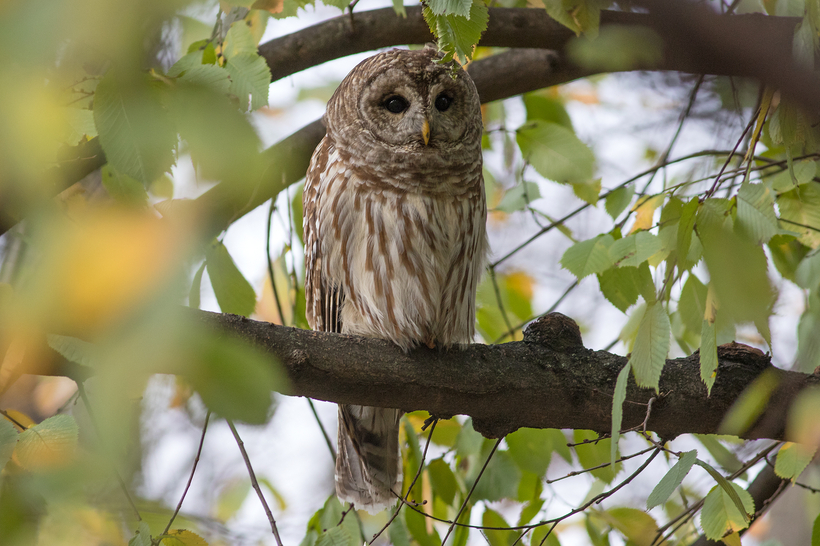The new year sailed in on wisdom and wings. We have a President-elect who is deeply experienced, empathetic, and open-hearted. When asked about Republicans who wouldn’t acknowledge his win, or might not work with him, he didn’t rant and rave. He simply smiled and assured us, “They will. They will.” He’s been, in a word, unflappable.
Here in New York City, the winter has seen a parliament of owls. Well, not in the strictest sense, because a “parliament” means a number of owls grouped together. But along with the usual species—Long-eared or Great Horned here, Northern Saw-whet or Eastern Screech there—three Barred Owls have been present in Manhattan. All were reported on December 20th’s Christmas Bird Count: one in Central Park, one in the woods of Inwood, and one in Riverside Park.
The Barred Owl is a chunky, big-headed bird of the forest, dressed in shades of pale buff and brown, and named for its beautiful barring—horizontal bars on a collar of dense feathers, vertical bars on the breast. The species is occasionally seen in Central Park, but has never before been sighted in Riverside Park, where it is now a star attraction in the vicinity of Columbia University, no surprise seeing that owls are allied with Athena, goddess of wisdom.
Along with the usual owls—Long-eared or Great Horned here, Northern Saw-whet or Eastern Screech there—three Barred Owls have been present in Manhattan.
The special gift of the Columbia owl is that she (or he, not sure which) roosts in the limbs of trees along the retaining wall in the park’s Forever Wild section (also known as the Riverside Park Bird Sanctuary), and is easily visible from the sidewalk on Riverside Drive. The bird, which locals have nicknamed “Barnard,” is unruffled by the surrounding human activity. It receives daily visitors, sometimes crowds, and is spurring a baby boom of new birders—and not a moment too soon. Earlier this month, in signature cruelty, the Trump administration gutted a profound century-old protection for birds, a rollback that allows the oil and gas industry to pollute without punishment.
Any day that you see an owl is special. Watching one still and silent on a branch—its eyes closed, body bunched, and feathers fluffed—is strangely wonderful. In film and theater stillness can be irritating or mesmerizing. When Andy Warhol showed his five-hour-plus film Sleep, the camera continuously trained on his sleeping lover John Giorno, people in the audience shouted at the screen and left. In Frederick Ashton’s 1952 ballet Sylvia, when a statue of Eros—located in an elevated archway upstage—comes to life to shoot an arrow, it is a surprise and a delight. Though the Barred Owl may be napping, it turns its head and lifts its lids when another bird flies close or there is bustle down below.

And those eyes! Like twin eclipses. Where the owl species mentioned above have catlike golden eyes and dark pupils, the Barred Owl’s are liquid black. These eyes are not predatory but childlike. They lend the species an alien innocence. Indeed, looking into the eyes of this owl, I thought of The Child in the Disney+ Star Wars franchise The Mandalorian. Its name is Grogu and it is the same species as Yoda. Because it is still an infant its pupils are huge, a blackness brimming with the mysterious unknown. They are no small part of the powerful limbic response it pulls from us.
Grogu, whose tiny robe has a collar much like the Barred Owl’s, is connected to The Force. Instinctually, the Mandalorian knight knows he must protect it. This is the Way.
Laura Jacobs is AIR MAIL’s Arts Intel Report Editor
